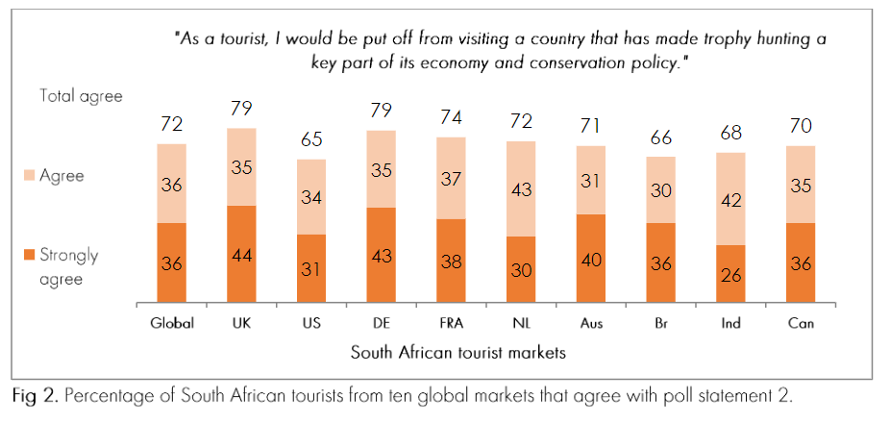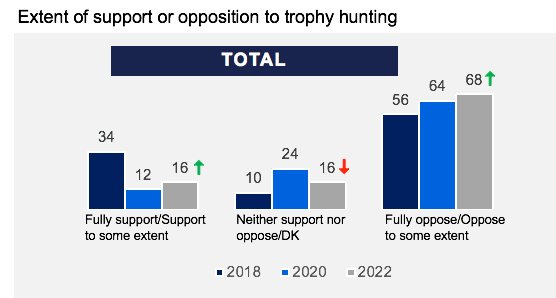Despite the growing opposition to trophy hunting, foreign hunters — mainly American — still stream in to shoot and kill every imaginable species of animal from squirrels, African wild cats and blue duikers to the rarest, such as Lichtenstein’s hartebeest and the largest, such as elephants and hippos. They even target endangered aardvarks.
Between 2016 and 2020, hunters killed a staggering 174,000 animals in SA.
World Animal Protection (WAP) commissioned research surveying 10,900 people from around the world, including international tourists from countries who most frequently visit South Africa, as well as South African citizens. It found universal opposition to blood sports and a strong desire to finance the protection of wildlife through non-lethal alternatives such as responsible tourism.
Key findings from the research showed:
- At least 84% of international tourists agree that the South African government should prioritise wildlife-friendly tourism over trophy hunting.
- At least 74% agreed that making trophy hunting a key pillar of policy will damage South Africa’s reputation and 72% would be put off from visiting the country altogether.
- Seven in 10 South African citizens agreed their country would be a more attractive tourist destination if trophy hunting was banned.
- Three-quarters of South African citizens agreed that trophy hunting was unacceptable when wildlife-friendly tourism alternatives have not been fully utilised.

A survey of 599 people by Humane Society International/Africa, conducted across all provinces, also found considerable objection to trophy hunting among all race and gender groups, six language groups and a range of ages and household incomes, both urban and rural.
Opposition to trophy hunting continued to grow from their (2020) survey, with a 4% increase in opposition to trophy hunting overall, taking opposition levels among the South African adult population to 68%.

World Animal Protection welcomed the May 2021 recommendations from South Africa’s Department of Forestry, Fisheries and the Environment (DFFE) to halt the domestication of captive lions, as well as the phasing out of the commercial captive lion industry. But it said progressive steps had seemingly stalled, with little progress taking place in the year that followed.
 New research: Trophy hunting puts South Africa’s tourism industry in Limbo
New research: Trophy hunting puts South Africa’s tourism industry in Limbo
The HSI/Africa poll was extremely fine-grained, drilling down into views on the hunting of a number of iconic animals. The percentages of people objecting to trophy hunts were:
All trophy hunting — 68%
Canned lion hunting — 65%
Elephants — 64%
Rhinos — 64%
Leopards — 64%
Lions — 63%
Hippos — 66%
Giraffes — 67%
Objections to foreign hunters exporting trophies for elephants, black rhinos and leopards were all above 60%.
In terms of race, the highest objection to trophy hunting came from Indians (91%), followed by whites (73%), coloureds (70%) and blacks (66%). There was roughly a 50-50 parity between genders.
The survey noted that opposition to trophy hunting is more marked among the younger age group (15-17) at 79%, compared with 68% of those between 25 and 34. This trend was consistent across all results.
There were clear regional differences when it came to opposition to canned lion hunting, being lowest by far among residents of the Free State (36%), possibly because of the high level of hunting and captive breeding of wild animals in the region.
“Our new survey shows without a doubt,” said HSI/Africa wildlife specialist Dr Matthew Schurch, “that most South Africans reject the unjustifiable practice of trophy hunting, including canned lion hunting, and opposition to trophy hunting continues to grow.
SA government ‘out of step’
“The South African government is out of step with public opinion because it allows people to hunt wild animals for the purpose of collecting their remains to adorn their homes. Trophy hunting does not significantly contribute to conservation.
“In South Africa, one-third of hunting trophies of CITES-listed mammals are from captive bred animals. This senseless killing of wild animals is not only unethical and cruel, but a disgrace to brand South Africa.”
Commenting on the results of the World Animal Protection survey, its wildlife campaign manager, Edith Kabesiime, said it was clear the public understood that “life of a wild animal is worth so much more than the trophy it is too often reduced to”.
This view was shared by tourists, who come to see wildlife alive and thriving, as well as South Africans who “want to see the incredible wildlife on their doorstep, protected properly, in a humane and ethical manner”.
Bipolar policy
The surveys coincide with South Africa’s White Paper on animal welfare and sustainable use of biodiversity and a call for a committee to discuss the shutting down of lion farms. But in the bipolar way that environmental policy in South Africa seems to specialise, this coincided with the issue of the Environment Department’s Draft Game Meat Strategy aiming to double the consumption of meat from wildlife by 2030. This is seen as a threat to wildlife genetic health and the possibility of wildlife feedlot farming.
According to the Professional Hunters Registers supplied by DFFE, the annual number of foreign trophy hunters entering South Africa averaged around 8,000 (apart from 2020, because of the pandemic).
Between 2016 and 2020 they shot 173,822 wild animals from 83 species. Most hunters came from the United States (4,614 in 2019); the rest, in descending order, from Denmark, Germany, Spain, Canada, Sweden, Mexico and Russia.
A sample of their trophies now mounted or hanging on walls include:
Aardvark — 21
Baboon — 1,655
Bat-eared fox — 56
Buffalo — 4,258
Dassie — 84
Gemsbok — 9,600
Giraffe — 1,340
Ground squirrel — 37
Hippo — 285
Honey badger — 194
Impala — 24,591
Jackal — 1,185
Kudu — 12,637
Lion — 1,636
Polecat — 17
Rhino — 275
Samango monkey — 29
Sable antelope — 4,885
Springbok — 10,587
Suni — 53
Vervet monkey — 913
Warthog — 17,749
Wildebeest — 12,282
Zebra — 10,223
Daily Maverick obtained a 2019 average price list per species, indicating what foreigners are prepared to pay to hunt in South Africa. Here are a few examples:
Baboon — $248
Cheetah — $5,000
Elephant — $26,500
Giraffe — $3,000
Hyena — $3,500
Leopard — $7,830
Lion — $10,000
Cape clawless otter — $100
Sable antelope — $5,414
Ground squirrel — $50
Warthog — $448
Hartman’s zebra — $2,260
Ostrich — $766
Crocodile — $5,700
Emu — $500
Camel — $500
“The government needs to listen to South African voices who clearly don’t want their wildlife heritage plundered any further and want to see change,” said Kabesiime.
She said that without taking a firm stand, South Africa was starving the oxygen from creative thinking to identify, incentivise and implement non-lethal alternatives to conserve wildlife.
“Wildlife has the right to a wild life free from cruel commercial exploitation. We need to respect and protect them.” DM/OBP
















